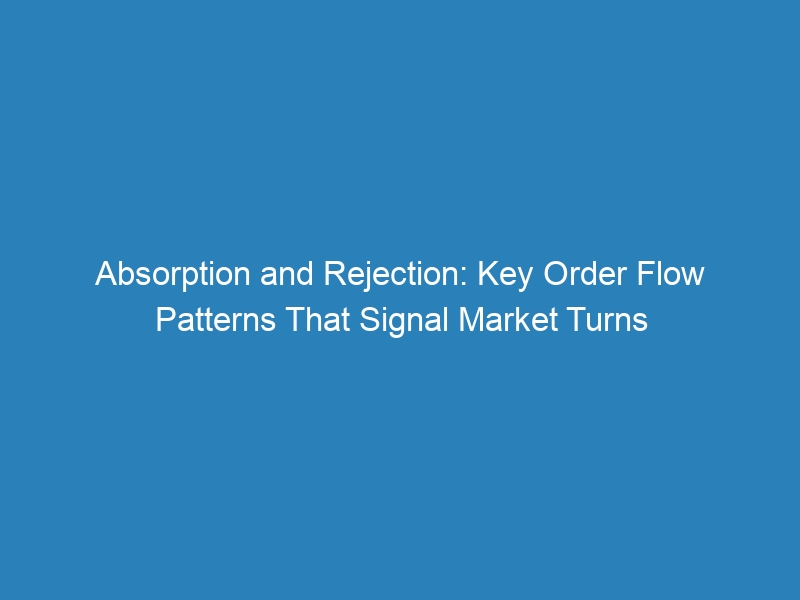Absorption and Rejection: Key Order Flow Patterns That Signal Market Turns

Understanding the intricacies of order flow can significantly enhance your market trading strategies. This article will explore the fundamental concepts of order flow, with a focus on the critical phenomena of absorption and rejection.
You will gain clear definitions of these terms, identify their key characteristics, and uncover patterns that may signal market turns. Additionally, you will discover practical strategies to take advantage of these findings for trading and investing, supported by real-world case studies that demonstrate their effectiveness.
Engaging with this material will help you sharpen your market intuition and make more informed decisions.
Understanding Order Flow in the Market
Understanding order flow in the market is crucial for you as a trader, as it provides insights into market dynamics and the underlying psychology of participants.
By analyzing how orders are executed, you can identify key patterns and trends, which will ultimately aid you in making informed trading decisions.
This process involves examining the interplay between buyers and sellers, recognizing liquidity zones, and interpreting trading signals that may indicate potential market turns.
Mastering order flow analysis enables you to develop effective trading strategies that align with market sentiment, thereby enhancing your chances of success across various asset classes.
What is Order Flow?
Order flow refers to the buying and selling activity in the market, indicating how orders are executed and their impact on price movements. It provides you with a real-time perspective on market dynamics by revealing the motives behind trades, whether those are driven by retail traders or institutional trading strategies.
To understand order flow, it is essential to analyze several crucial components, including execution speed. This factor is critical in determining how quickly trades are processed and how that speed affects price movements. Execution speed plays a significant role in market indicators, as you rely on efficient transactions to inform your strategies.
Order flow directly impacts trading volume by illustrating investor behavior, which in turn influences market efficiency. An increase in transaction speed and the resulting market activity can enhance liquidity, making it easier for participants to enter and exit positions without excessive impact on prices.
Therefore, gaining a deeper understanding of order flow can provide you with essential insights to navigate the complexities of the market effectively.
The Role of Absorption and Rejection in Market Turns
Absorption and rejection are crucial concepts for understanding market turns, as they provide insights into price action behavior around key support and resistance levels.
Absorption takes place when buyers or sellers are overwhelmed by heightened trading activity, whereas rejection indicates that the market is not prepared to break through these levels.
By recognizing these patterns, you can significantly enhance your ability to anticipate future price movements and develop effective trading strategies.
Defining Absorption and Rejection
Absorption refers to a scenario in which large orders are filled within a specific price range, resulting in a temporary pause in price movement. Conversely, rejection occurs when the price fails to break through established levels, indicating a potential trend reversal.
Understanding these concepts is essential for traders who seek to navigate the complexities of market sentiment and price fluctuations effectively. Absorption can indicate that buyers are actively consuming available supply, which may precede a bullish move. In contrast, rejection often signifies strong selling pressure that could suggest a bearish trend.
By incorporating these definitions into your trading strategies, you can better anticipate market behavior and adjust your entry and exit points accordingly. Observing patterns of absorption and rejection can enhance your decision-making process, ultimately leading to more informed trades and improved risk management.
Identifying Absorption and Rejection Patterns
Identifying absorption and rejection patterns is crucial for traders aiming to capitalize on market turns, as these patterns frequently indicate potential entry and exit points.
By analyzing key characteristics and employing various indicators, traders can cultivate a comprehensive understanding of price action and the underlying market dynamics. This knowledge enables well-considered choices and enhances the overall trading strategy.
Key Characteristics and Indicators
You can recognize key characteristics of absorption and rejection patterns by observing specific indicators and understanding market structure, including changes in trading volume and price levels that signal potential market sentiments.
These patterns provide valuable insights into market dynamics, revealing the underlying forces at play. For example, when the price approaches significant support or resistance levels, a sudden shift in volume may indicate absorption, suggesting strong buying interest. On the other hand, a rejection pattern may arise when sellers outnumber buyers, leading to price reversals after reaching these critical levels.
To effectively utilize these characteristics, you should monitor volume spikes in conjunction with price movements, as these elements often validate the presence of either absorption or rejection, ultimately aiding in clearer market predictions.
Using Absorption and Rejection to Predict Market Turns
Utilizing absorption and rejection to predict market turns can significantly enhance your trading strategies, offering powerful tools for identifying entry and exit signals.
By comprehending these patterns, you can effectively manage risk and make informed decisions based on market behavior.
Strategies for Trading and Investing
Developing effective trading strategies that incorporate absorption and rejection patterns can assist you in navigating market volatility and avoiding false breakouts. By leveraging momentum and understanding price action, you can enhance your trading performance.
To successfully implement these strategies, it is crucial for you to familiarize yourself with key indicators that signal absorption and rejection.
For instance, a sharp price movement followed by a lack of follow-through may indicate absorption, suggesting that the market is consolidating before a potential breakout. Conversely, if a price surge struggles to maintain its gains, it may signify rejection, indicating a possible reversal.
Identifying these patterns while monitoring momentum can significantly bolster your decision-making process. Utilizing stop-loss orders strategically will allow you to navigate unexpected fluctuations without incurring significant risk.
Recognizing these critical patterns can enable you to seize opportunities and protect against false breakouts in dynamic market conditions.
Real-World Examples of Absorption and Rejection in Action
Real-world examples of absorption and rejection in action can offer invaluable insights into market analysis, demonstrating how these patterns manifest across various financial markets.
By examining case studies, you can gain a deeper understanding of the implications of trading volume and market behavior in real-time scenarios.
Case Studies and Analysis
Case studies and analyses of absorption and rejection patterns reveal the nuances of market dynamics, demonstrating how price action behaves across various asset classes.
By closely examining these patterns, you can uncover critical insights into investor behavior and market sentiment. For instance, in the realm of equities, analyzing past trends of absorption can show how buyers accumulate shares before a price surge.
Conversely, rejection patterns often serve as warning signals for potential market corrections, providing you with strategic entry and exit points.
Similarly, in commodities and real estate, these patterns can aid in predicting significant price movements, guiding you in making informed investment decisions.
Ultimately, understanding these dynamics fosters a deeper comprehension of market cycles and enhances your trading strategies.
Frequently Asked Questions
What is absorption and rejection in relation to market turns?
Absorption and rejection are two key order flow patterns that signal potential market turns. These are observed when an increase in buying or selling pressure is met with an equal or greater amount of selling or buying pressure, respectively. This results in the market being unable to continue in its current direction, potentially leading to a reversal in price.
What is the significance of understanding absorption and rejection in trading?
Understanding absorption and rejection can be critical for traders as it can provide valuable insights into market sentiment and potential price movements. These patterns can help traders identify potential turning points in the market and make more informed trading decisions.
How can one identify absorption and rejection patterns?
Absorption and rejection patterns can be identified through analyzing price charts and volume data. Traders can look for instances where an increase in buying or selling volume is met with an equal or greater amount of selling or buying volume, respectively. This can be seen as a sign of absorption or rejection, signaling a potential market turn.
What are some key factors to consider when observing absorption and rejection patterns?
When looking for absorption and rejection patterns, it is important to consider the context in which they occur. Factors such as market volatility, news events, and overall market trend can greatly influence the significance of these patterns. Additionally, the strength and duration of these patterns should also be taken into account.
Can absorption and rejection patterns be used in any market or asset?
Absorption and rejection patterns can be observed in various markets and assets, including stocks, forex, and commodities. However, it is important to note that the effectiveness of these patterns may vary depending on the specific market and asset being traded.
Are absorption and rejection patterns always reliable indicators of market turns?
While absorption and rejection patterns can provide valuable insights into potential market turns, they should not be relied upon as the sole basis for trading decisions. It is important to use other technical and fundamental analysis tools to confirm these patterns and make more informed trading decisions.
Absorption and rejection patterns are key indicators of market sentiment and potential turning points. To deepen your understanding of these crucial concepts, explore our comprehensive guide on order flow absorption and rejection patterns explained with examples. Master the art of reading market dynamics.


Recent Comments